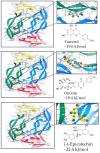Drug Screening of Flavonoids as Potential VEGF Inhibitors Through Computational Docking and Cell Models
- PMID: 39860127
- PMCID: PMC11767819
- DOI: 10.3390/molecules30020257
Drug Screening of Flavonoids as Potential VEGF Inhibitors Through Computational Docking and Cell Models
Abstract
Vascular endothelial growth factor (VEGF), also known as VEGF-A, has been linked to various diseases, such as wet age-related macular degeneration (wAMD) and cancer. Even though there are VEGF inhibitors that are currently commercially available in clinical applications, severe adverse effects have been associated with these treatments. There is still a need to develop novel VEGF-based therapeutics against these VEGF-related diseases. Here, we established a series of VEGF-based computational docking analyses and cell models, such as a wound healing assay in HaCaT cells and an evaluation of NF-κB performance in macrophages, to screen a large library of flavonoid-type phytochemicals. Three flavonoids, namely, farrerol, ononin and (-)-epicatechin, were shown to express binding affinities to VEGF protein and inhibit VEGF-mediated biological activities. The investigation evidently suggested that the three flavonoids above could be considered potential anti-VEGF agents for the following drug development against VEGF-mediated diseases.
Keywords: VEGF inhibitor; angiogenesis; computational docking; drug screening; flavonoids.
Conflict of interest statement
The authors declare no conflicts of interest.
Figures




Similar articles
-
Design, Synthesis, and Biological Evaluations of a Novel Resveratrol-Type Analogue Against VEGF.Molecules. 2025 May 27;30(11):2345. doi: 10.3390/molecules30112345. Molecules. 2025. PMID: 40509232 Free PMC article.
-
The binding of kaempferol-3-O-rutinoside to vascular endothelial growth factor potentiates anti-inflammatory efficiencies in lipopolysaccharide-treated mouse macrophage RAW264.7 cells.Phytomedicine. 2021 Jan;80:153400. doi: 10.1016/j.phymed.2020.153400. Epub 2020 Oct 26. Phytomedicine. 2021. PMID: 33157413
-
Anti-angiogenic Activity of Major Phenolics in Tamarind Assessed with Molecular Docking Study on VEGF Kinase Proteins.Pak J Biol Sci. 2019 Jan;22(10):502-509. doi: 10.3923/pjbs.2019.502.509. Pak J Biol Sci. 2019. PMID: 31930840
-
Vascular endothelial growth factor (VEGF) and VEGF receptor inhibitors in the treatment of renal cell carcinomas.Pharmacol Res. 2017 Jun;120:116-132. doi: 10.1016/j.phrs.2017.03.010. Epub 2017 Mar 19. Pharmacol Res. 2017. PMID: 28330784 Review.
-
Vascular Endothelial Growth Factor Antagonists: Promising Players in the Treatment of Neovascular Age-Related Macular Degeneration.Drug Des Devel Ther. 2021 Jun 21;15:2653-2665. doi: 10.2147/DDDT.S295223. eCollection 2021. Drug Des Devel Ther. 2021. PMID: 34188445 Free PMC article. Review.
Cited by
-
Design, Synthesis, and Biological Evaluations of a Novel Resveratrol-Type Analogue Against VEGF.Molecules. 2025 May 27;30(11):2345. doi: 10.3390/molecules30112345. Molecules. 2025. PMID: 40509232 Free PMC article.
References
MeSH terms
Substances
LinkOut - more resources
Full Text Sources

